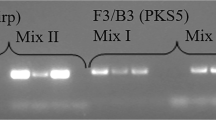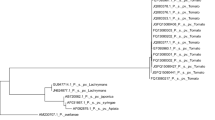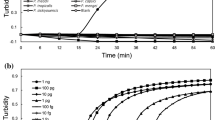Abstract
Loop-mediated isothermal amplification (LAMP) was designed to rapidly detect biovars 1 and 3 of Pseudomonas syringae pv. actinidiae (Psa), a serious, global kiwifruit pathogen, using two primer sets targeting biovar-specific type III effector genes. Each primer set was specific for the targeted biovars, and no signals were obtained for any other biovars. Detection limits of the assay were tenfold higher than that of the conventional PCR method for both biovars. The primer set to detect biovar 3 was highly sensitive at detecting this biovar directly from leaf lesions.
Similar content being viewed by others
References
Balestra GM, Mazzaglia A, Quattrucci A, Renzi M, Rossetti A (2009) Current status of bacterial canker spread on kiwifruit in Italy. Austral Plant Dis Notes 4:34–36
Balestra GM, Taratufolo MC, Vinatzer BA, Mazzaglia A (2013) A multiplex PCR assay for detection of Pseudomonas syringae pv. actinidiae and differentiation of populations with different geographic origin. Plant Dis 97:472–478
Cameron A, Sarojini V (2014) Pseudomonas syringae pv. actinidiae: chemical control, resistance mechanisms and possible alternatives. Plant Pathol 63:1–11
Chapman JR, Taylor RK, Weir BS, Romberg MK, Vanneste JL, Luck J, Alexander BJR (2012) Phylogenetic relationships among global populations of Pseudomonas syringae pv. actinidiae. Phytopathology 102:1034–1044
Chen Q, Benjin L, Peiqing L, Chengzhong L, Zhixiong Z, Qiyong Y (2013) Development and evaluation of specific PCR and LAMP assays for the rapid detection of Phytophthora melonis. Eur J Plant Pathol 137:597–607
Cunty A, Poliakoff F, Rivoal C, Cesbron S, Fischer-Le Saux M, Lemaire C, Jacques MA, Manceau C, Vanneste JL (2015) Characterization of Pseudomonas syringae pv. actinidiae (Psa) isolated from France and assignment of Psa biovar 4 to a de novo pathovar: Pseudomonas syringae pv. actinidifoliorum pv. nov. Plant Pathol 64:582–596
European and Mediterranean Plant Protection Organization (2014) PM 7/120(1) Pseudomonas syringae pv. actinidiae. EPPO Bull 44:360–375
Ferrante P, Scortichini M (2009) Identification of Pseudomonas syringae pv. actinidiae as causal agent of bacterial canker of yellow kiwifruit (Actinidia chinensis Planchon) in central Italy. J Phytopathol 157:768–770
Ferrante P, Scortichini M (2011) Molecular and phenotypic variability among Pseudomonas avellanae, P. syringae pv. actinidiae and P. syringae pv. theae: the genomospecies 8 sensu Gardan et al. (1999). J Plant Pathol 93:659–666
Fujikawa T, Aono M, Nakaune R (2018) New medium for sorting of Pseudomonas syringae pv. actinidiae (abstract in Japanese). Jpn J Phytopathol 84:48–49
Fusayasu S, Sato T, Shimizu H (2006) Detection of citrus greening disease (Candidatus Liberobacter asiaticum) by loop-mediated isothermal amplification (in Japanese). Res Bull Plant Prot Jpn 42:81–87
Gallelli A, Talocci S, Pilotti M, Loreti S (2014) Real-time and qualitative PCR for detecting Pseudomonas syringae pv. actinidiae isolates causing recent outbreaks of kiwifruit bacterial canker. Plant Pathol 63:264–276
Goto M, Honda E, Ogura A, Nomoto A, Hanaki K (2009) Colorometric detection of loop-mediated isothermal amplification reaction by using hydroxy naphthol blue. Biotechniques 46:167–172
Lalkhen AG, McCluskey A (2008) Clinical tests: sensitivity and specificity. Contin Educ Anaesth Crit Care Pain 8:221–223
McCann HC, Rikkerink EHA, Bertels F, Fiers M, Lu A, Rees-George J, Andersen MT, Gleave A, Haubold B, Wohlers MW, Guttman DS, Wang PW, Straub C, Vanneste J, Rainey PB, Templeton MD (2013) Genomic analysis of the kiwifruit pathogen Pseudomonas syringae pv. actinidiae provides insight into the origins of an emergent plant disease. PLoS Pathog 9:e1003503
Ministry of Agriculture, Forestry and Fisheries (2018) Manual for control of bacterial canker of kiwifruit caused by Pseudomonas syringae pv. actinidiae biovar 3 (Psa3), 3rd ed (in Japanese). Available at https://www.maff.go.jp/j/syouan/syokubo/gaicyu/siryou2/attach/pdf/index-14.pdf. Cited 23 Dec 2020
Miyoshi T, Shimizu S, Sawada H (2012) Occurrence and distribution of a defective non-phaseolotoxin-producing mutant of Pseudomonas syringae pv. actinidiae in Ehime Prefecture, Japan (in Japanese with English summary). Jpn J Phytopathol 78:92–103
Mohan SK, Schaad NW (1987) An improved agar plating assay for detecting Pseudomonas syringae pv. syringae and P. s. pv. phaseolicola in contaminated bean seed. Phytopathology 77:1390–1395
Mori Y, Nagamine K, Tomita N, Notomi T (2001) Detection of loop-mediated isothermal amplification reaction by turbidity derived from magnesium pyrophosphate formation. Biochem Biophys Res Commun 289:150–154
Notomi T, Okayama H, Masubuchi H, Yonekawa T, Watanabe K, Amino N, Hase T (2000) Loop-mediated isothermal amplification of DNA. Nucl Acid Res 28:e63
R Core Team (2018) R: a language and environment for statistical computing. R Foundation for Statistical Computing, Vienna
Ruinelli M, Schneeberger PHH, Ferrante P, Buehlmann A, Scortichini M, Vanneste JL, Duffy B, Pothier JF (2017) Comparative genomics-informed design of two LAMP assays for detection of the kiwifruit pathogen Pseudomonas syringae pv. actinidiae and discrimination of isolates belonging to the pandemic biovar 3. Plant Pathol 66:140–149
Sawada H, Fujikawa T (2019) Genetic diversity of Pseudomonas syringae pv. actinidiae, pathogen of kiwifruit bacterial canker. Plant Pathol 68:1235–1248
Sawada H, Miyoshi T, Ide Y (2014) Novel MLSA group (Psa5) of Pseudomonas syringae pv. actinidiae causing bacterial canker of kiwifruit (Actinidia chinesis) in Japan (in Japanese with English summary). Jpn J Phytopathol 80:171–184
Sawada H, Shimizu S, Miyoshi T, Shinozaki T, Kusumoto S, Noguchi M, Naridomi T, Kikuhara K, Kansako M, Fujikawa T, Nakaune R (2015) Characterization biovar 3 strains of Pseudomonas syringae pv. actinidiae isolated in Japan (in Japanese with English summary). Jpn J Phytopathol 81:111–126
Sawada H, Kondo K, Nakaune R (2016) Novel biovar (biovar 6) of Pseudomonas syringae pv. actinidiae causing bacterial canker of kiwifruit (Actinidia deliciosa) in Japan (in Japanese with English summary). Jpn J Phytopathol 82:101–115
Serizawa S, Ichikawa T (1993) Epidemiology of bacterial canker of kiwifruit 3. The seasonal changes of bacterial population in lesions and of its exudation from lesions. Ann Phytopathol Soc Jpn 59:469–476
Serizawa S, Ichikawa T, Takikawa Y, Tsuyumu S, Goto M (1989) Occurrence of bacterial canker of kiwifruit in Japan: description of symptoms, isolation of the pathogen and screening of bactericides. Ann Phytopathol Soc Jpn 55:427–436
Takikawa Y, Serizawa S, Ichikawa T, Tsuyumu S, Goto M (1989) Pseudomonas syringae pv. actinidiae sp. nov.: the causal bacterium of canker in kiwifruit in Japan. Ann Phytopathol Soc Jpn 55:437–444
Tyson JL, Curtis CL, Manning MA, Dobson SJ, McKenna CE (2016) Preliminary investigation of the risk of plant debris as a Pseudomonas syringae pv. actinidiae inoculum source. N Z Plant Prot 69:11–16
Funding
This study was supported by a Grant-in-Aid from the Science and Technology Research Promotion Program for Agriculture, Forestry, Fisheries and Food Industry of the Ministry of Agriculture, Forestry and Fisheries (27008C).
Author information
Authors and Affiliations
Contributions
All authors contributed to the study conception and design. Material preparation, data collection and analysis were performed by KS, HS, and GK. The first draft of the manuscript was written by KS. All authors commented on previous versions of the manuscript and read and approved the final manuscript.
Corresponding author
Ethics declarations
Conflict of interest
The authors have no conflicts of interest to declare that are relevant to the content of this article.
Human and animal rights
No human participants or animals were involved in this study.
Additional information
Publisher's Note
Springer Nature remains neutral with regard to jurisdictional claims in published maps and institutional affiliations.
Supplementary Information
Below is the link to the electronic supplementary material.
Rights and permissions
About this article
Cite this article
Suzaki, K., Sawada, H. & Kisaki, G. Loop-mediated isothermal amplification of bacterial effector genes to detect Pseudomonas syringae pv. actinidiae biovars 1 and 3. J Gen Plant Pathol 88, 2–9 (2022). https://doi.org/10.1007/s10327-021-01030-9
Received:
Accepted:
Published:
Issue Date:
DOI: https://doi.org/10.1007/s10327-021-01030-9




